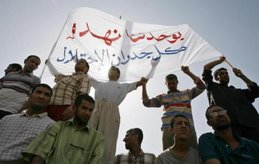Massive escalation of air war in Iraq
Saleh Mamon, Iraq Occupation Focus, explores a little-reported but alarming trend in the occupation of Iraq.
Januray 2008
The Iraq war is as much about slick ‘public relations’ as military manoeuvres. In the second half of 2007, there was a concerted drive in the corporate media to be ‘on message’ that peace is returning to Iraq following the ‘surge’, a deceitful euphemism for escalation. Making the war domestically acceptable involves showing progress, however illusory, and relegating it to the back pages of newspapers and keeping it a maximum distance from TV cameras. What is paramount for the US is the reduction of American casualties. This requires the avoidance of active fighting by US ground troops by not only using more Iraqi troops and police in the front line, but also using overwhelming air power.
Every day the U.S. Central command (CENTAF) released an ‘airpower summary’ detailing ‘close-air-support’ (CAS) missions in Iraq and Afghanistan. In Iraq, after the 2003 invasion, the numbers of CAS strikes with munitions dropped were: 285 (2004), 404 (2005), 229 (2006) and 1447 (2007). Hence from 2006 to 2007, there was a 500% increase in bombing raids, a massive escalation compared to the ‘surge’ in ground troop numbers by 30,000, an approximate increase of 20%.
The most frequently used bomb is a Guided Bomb Unit 12, a laser guided bomb with a 500-pound general purpose warhead. This is capable of reducing a mansion to rubble. In 2006, 111,000 pounds of bombs were dropped on targets in Iraq. Extrapolating for 2007, we can reasonably estimate that 500,000 pounds were dropped.
January 2008 saw a massive strike south of Baghdad involving 38 bombers dropping 40.000 pounds of ordnance in 10 minutes [on the village of Arab Jebour]. This is a portent of the kind of high tech destruction Iraqis will face in coming months.
These figures do not include guided missiles, unguided rockets, and cannon rounds fired by USAF, the Marine Corp and Special Forces. One weapon conspicuously left out is the 2.75 inch Hydra-70 rocket which can be outfitted with various warheads and has become the most widely used helicopter-launched weapon system. Special Forces often use aircraft such as AC-130 gunships which have a Gatling gun that can fire up to 1,800 rounds in a single minute. The damage caused by these munitions is significant.
The number of Iraqi casualties has been fiercely contested by various parties. The survey published in the Lancet estimated that from March 2003 to June 2006, 13% of the excess 601,000 violent deaths were caused by air strikes. The authors of the report have also attributed half the deaths of Iraqi children under 15 to air strikes. With a fivefold increase in bombings, Iraqi fatalities can be expected to increase proportionately. We do not have any map of the damage to populated urban areas and villages throughout Iraq. There have been vivid eyewitness accounts of the destruction in Fallujah and Baghdad where residential and commercial buildings have been reduced to rubble.
The vast increase in internally displaced people (about 2 million) and refugees outside Iraq (over 2 million) bears witness to this devastation. Reports from OXFAM and Amnesty paint a bleak picture of this humanitarian catastrophe. However, these reports highlight sectarian strife as the main cause. This overlooks the impact of bombings as a significant cause for displacement of people. Historical evidence attests that the US ‘air support’ displaced 25% of the population in Laos, 33% in Vietnam and almost a million people in Cambodia during the 1960s.
It is ironic that the mission to bring ‘freedom and democracy’ to Iraq has been reduced to destruction of human beings, homes, infrastructure and means of production in the name of counter-insurgency. The occupation can be sustained only through violence and has no moral or political legitimacy. There is an urgent need to bring the massive escalation of the air war to the attention of the wider public through whatever channels we can. All civil society organisations and activists should campaign to stop the bombings in Iraq and bringing this human catastrophe to an end.









